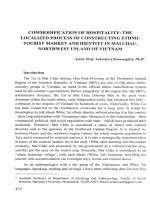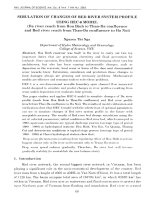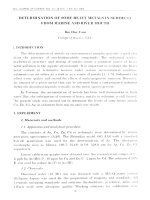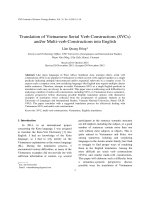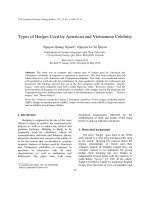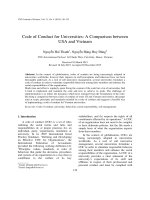DSpace at VNU: Improvement of nutritional composition and antioxidant capacity of high-amylose wheat during germination
Bạn đang xem bản rút gọn của tài liệu. Xem và tải ngay bản đầy đủ của tài liệu tại đây (298.58 KB, 7 trang )
J Food Sci Technol
DOI 10.1007/s13197-015-1730-6
ORIGINAL ARTICLE
Improvement of nutritional composition and antioxidant capacity
of high-amylose wheat during germination
Pham Van Hung & Tomoko Maeda & Naofumi Morita
Revised: 5 January 2015 / Accepted: 7 January 2015
# Association of Food Scientists & Technologists (India) 2015
Abstract High-amylose wheat was subjected to various germination conditions and changes in its nutritional values and
antioxidant capacity were investigated. Amounts of soluble dietary fiber, total protein and free lipid of germinated highamylose wheat increased with increased germination times,
whereas no significant changes were observed for insoluble
dietary fiber and free fatty acids. Total free amino acid contents
of high-amylose wheat gradually increased from 129.7 to
314.4 mg/100 g of grain (db) during 48 h of germination. As
compared to ungerminated wheat, essential and functional amino acids including isoleucine, leucine, phenylanaline, valine
and gamma-amino butyric acid in the 48 h-germinated wheat
increased by 3–10 times. Total phenolic contents of both free
and bound phenolics and their antioxidant capacities significantly increased after 24 h of germination and were further
improved with prolonged germination times. It appears that
nutritional values and bioactive compounds of high amylose
wheat significantly improved for enhanced food applications.
Keywords High-amylose wheat . Germination . Nutrition .
Antioxidant
P. Van Hung (*)
School of Biotechnology, International University,
Vietnam National University, Quarter 6, Linh Trung Ward,
Thu Duc District HoChiMinh City, Vietnam
e-mail:
T. Maeda
Department of Life and Health Sciences,
Hyogo University of Teacher Education, 942-1, Shimokume,
Yashiro, Hyogo 673-1494, Japan
N. Morita (*)
Department of Food Packaging Technology,
Toyo College of Food Technology, 4-3-2, Minami-Hanayashiki,
Kawanishi, Hyogo 666-0026, Japan
e-mail:
Introduction
Whole grains containing the nutritional constituents in bran
and germ have been reported to have significant health benefits. The consumption of whole grain foods was found to
prevent from several chronic diseases such as coronary cardiovascular disease (Bazzano et al. 2002), colon cancer
(Bingham et al. 2003) and diabetes (Anderson et al. 2004).
In wheat, bran and germ are rich in dietary fiber, vitamins,
minerals and bioactive compounds, which are always removed during milling by the conventional milling methods.
Therefore, the consumers are always encouraged to eat whole
wheat products such as whole wheat breads, cakes and noodles though the texture and mouthfeel quality of the whole
wheat products are reduced as compared to the white wheat
products.
In order to improve nutrients and sensory quality of whole
wheat foods, germination technologies has been widely
employed because the nutrients of whole grains including dietary fiber, free amino acids, phenolic compounds and antioxidant capacity have been reported to increase during germination (Hung et al. 2012; Nelson et al. 2013). Tkachuk (1979)
reported that the free amino acid content after 122 h of germination at 10, 16.5 and 25 °C was respectively 4×, 10× and 7×
that of ungerminated wheat. An increase in levels of ash and
dietary fiber was clearly observed for the 48 h-germinated
waxy wheat in the report of Hung et al. (2012). Free phenolic
compounds including ferulic acid, vanillic acid and syringic
acid as well as total phenolic compounds and antioxidant capacity of germinated wheat significantly increased as compared with ungerminated wheat (Hung et al. 2011, 2012). As
a result, sprouted food consumption has enjoyed growing popularity with health conscious consumers (Nelson et al. 2013).
Recently, wheat grains containing starch with various ratios
of amylose and amylopectin have been developed widely
using genetic techniques. High-amylose wheat (>37 %
J Food Sci Technol
amylose) was firstly produced in Japan by Dr. Yamamori’s
research group (Yamamori et al. 2000). The granular structure
and physicochemical properties of the high-amylose wheat
starches have been changed as compared to the normal wheat
starch due to the difference in the amylose/amylopectin ratios.
Hung et al. (2007) reported that the high-amylose wheat starch
had a significantly altered structure of amylopectin which did
not show any major peaks in the X-ray diffractogram.
Yamamori et al. (2000) also found that the short chains (DP
6–10) in amylopectin molecules of the high-amylose wheat
starch increased, whereas the level of DP 11–25 chains decreased. The high-amylose wheat was also found to have high
values of protein, ash, lipid and dietary fiber as compared to
the normal wheat (Morita et al. 2002). The unique structure
and characteristics of starch and flour composition of the highamylose wheat contributed to the new texture and quality of
the wheat-base food products such as bread and pasta. The
substitution with 50 % of high-amylose wheat flour for 1CW
(No. 1 Canada Western Red Spring) flour produced noodle
like pasta with the similar textural property to durum flour
(Morita et al. 2003). The high-amylose wheat flour was also
used to substitute for the normal wheat flour in breadmaking
to increase the amount of dietary fiber and resistant starch in
the breads (Hung et al. 2005). As a result, the high-amylose
wheats have been recently encouraged to be grown and applied for food processing to improve the texture and quality of
the end-use products. In order to improve its nutritional values
for wide food applications, high-amylose wheat was subjected
to germinate and the changes in chemical composition, nutritive values and antioxidant capacity during germination were
observed in this study.
Materials and methods
Materials
High-amylose wheat grains (~37.5 % amylose) were obtained
from Dr. Yamamori, National Agricultural Research Center
for Tohoku Region, Morioka, Japan. High-amylose wheat
was bred from Kanto 79/Turkey 116 F2 // Chousen 57
(Yamamori et al. 2000) and their F5 and F6 progeny without
SGP-1 were harvested in Nagano Prefecture in Japan in 2004.
The compound 1,1-diphenyl-1-picrylhydrazyl (DPPH),
Folin-Ciocalteu phenol reagent and other chemicals were
commercially purchased from Wako Chemical Co. (Osaka,
Japan). Total dietary fibre assay kit (TDF-100A) was obtained
from Sigma-Aldrich Co.
Germination conditions
The procedure of preparation and germination of highamylose wheat grains were the same procedure to that of waxy
wheat grains as previously reported (Hung et al. 2012).
Briefly, High-amylose wheat grains (~50 g) were initially
rinsed of their surface and soaked in excess distilled water
for 30 min at 25 °C before germination in a dark cabinet at
30 °C and a relative humidity of 85 % for 0, 6, 12, 24, 36 and
48 h. After incubation, the samples were washed carefully
with distilled water and then freeze-dried after freezing at
−84 °C. Freeze-dried samples and un-germinated grains
(control) were ground using a Retsch ZM1 milling apparatus
(Retsch, Haan, Germany) with a 0.5 mm mesh.
Determination of soluble, insoluble and total dietary fibers
Soluble, insoluble and total dietary fiber contents of the control and germinated high-amylose wheat grains were determined based on the AOAC method 985.29 (AOAC 1997)
using a total dietary fibre assay kit (Product code TDF100A, Sigma-Aldrich Co. Ltd.). Total dietary fiber content
was the sum of the soluble and insoluble dietary fiber
fractions.
Determination of total protein and free amino acids
Total protein contents of the control and germinated highamylose wheats were determined according to the standard
AACC International Approved method 46–10 (AACC
2000) using a Kjeltec Auto Sampler System 1035 Analyzer
(Tecator Ltd., Tokyo).
Free amino acids of the control and germinated highamylose wheats were determined according to the method of
Saikusa et al. (1994). Wheat flour (1.6 g) were homogenized
with 4 ml of 8 % trichloroacetic acid solution in test tubes (2×
16 cm) using a homogenizer for 5 min and then shaken (100
strokes/min; 5-cm amplitude) at 30 °C for 1 h. The suspension
was centrifuged at 4 °C and 14,000g for 15 min and the supernatant was recovered by filtration through a 0.45 μm membrane filter (Advantec Co., Ltd., Tokyo, Japan). Free amino
acids were analysed using a LC-11 Amino Acid Analyzer
(Yanaco Co., Kyoto, Japan).
Determination of free, bound and total lipids and fatty acid
composition
Free and bound lipids were extracted using a Soxhlet system
according to the Commission des Communautes Europeennes
(CEC) standard procedures (Ruibal-Mendieta et al. 2002).
Free lipids content was determined by extracting of wheat
flour (5 g) with hot diethyl ether (110 ml) using a Soxhlet
system for 6 h, recovering by a rotary evaporator under reduced pressure at 35 °C and then drying to constant weight at
105 °C. Bound lipids were extracted from the free lipidremoved residue. The residue was subjected to acid hydrolysis
in 100 ml hot 3 N HCl for 1 h, washed with at least 800 ml of
J Food Sci Technol
distilled water and then dried overnight at 70–75 °C. Finally,
the hydrolyzed residue was extracted with diethyl ether as
described previously. Total lipids were calculated by adding
free to bound lipid. Lipid content value is expressed as percentage of dry matter and is the means of duplicate
determinations.
Free fatty acid composition in free and bound lipids of germinated waxy wheat was determined using a gas-liquid chromatography (GLC). Free and bound lipids were extracted with
n-hexane as described above, then were used to prepare methylated fatty acids (FAME) using 14 % (w/v) boron trifluoride
(BF3) in methanol according to the method of Christie (1982).
The fatty acid composition was analysed using an Yanaco GLC
apparatus (Model G 3800, Osaka, Japan).
Determination of total phenolic compounds
and their antioxidant capacity
The contents of free and bound phenolics in the control and
germinated high-amylose wheats were determined according
to the method of Liyana-Pathirana and Shahidi (2007) with a
slight modification. Free phenolic compounds were extracted
from 1 g of wheat flour by shaking with 10 ml of 80 % chilled
ethanol for 20 min. The extraction was repeatedly done for 3
times and the combined supernatants were evaporated at
45 °C and reconstituted with methanol to a final volume of
10 ml. The extract were then stored at −40 °C until use. Bound
phenolic compounds were extracted 6 times with diethyl
ether-ethyl acetate (1:1) after alkaline hydrolysis of the residue
from free phenolic compound extraction. The ether-ethyl acetate extracts were evaporated to dryness and bound phenolic
compounds were reconstituted in 10 ml of methanol and then
stored at −40 °C until use.
The appropriate dilutions of free and bound phenolic extracts (0.5 ml) were oxidized with Folin-Ciocalteu’s reagent
(0.5 ml) in a centrifuge tube (50 ml). The reaction was neutralized with saturated sodium carbonate solution (1 ml),
followed by adjusting the volume to 10 ml with distilled water.
The contents in the tubes were thoroughly mixed and allowed
to stand at ambient temperature for 45 min until the characteristic blue color developed. Then the tubes were centrifuged
at 4,000g for 5 min. Absorbance of the clear supernatants was
measured at 725 nm using a spectrophotometer (UV-160A,
Shimadzu, Kyoto, Japan). The content of total phenolics in
each extract was calculated based on a standard curve prepared using ferulic acid and expressed as milligrams of ferulic
acid equivalent (FAE) per gram of sample. Standard calibration was made from 0, 20, 40, 60, 80 and 100 μg/ml.
Antioxidant capacity of free and bound phenolic extracts
were determined using the DPPH radical scavenging method
as previously described by Hung et al. (2011). A final concentration of DPPH solution (0.075 mM) was used for wheat
phenolic extracts. DPPH solution (3.9 ml) was mixed with
sample solution (0.1 ml). The mixture was kept in the
dark at ambient temperature. The absorbance of the
mixtures was recorded at 515 nm for exactly 30 min.
Blank was made from 3.9 ml of DPPH and 0.1 ml methanol
and measured absorbance at t=0. The scavenging of DPPH
was calculated according to the following equation (LiyanaPathirana and Shahidi (2007).
% DPPH scavenging ¼
ÈÀ
Á
É
Absðt¼0Þ – Absðt¼30Þ =Absðt¼0Þ Â 100
Where: Abs(t=0) = absorbance of DPPH radical + methanol
at t=0 min; Abs(t=30) = absorbance of DPPH radical + phenolic extracts at t=30 min.
Statistical analysis
All tests were performed at least in duplicate. Analysis of
variance (ANOVA) was performed using Duncan’s multiplerange test to compare treatment means at P<0.05 using SPSS
software version 16 (SPSS Inc., USA).
Results and discussion
Soluble, insoluble and total dietary fibers of germinated
high-amylose wheats
Changes of soluble, insoluble and total dietary fibers in highamylose wheat during 48 h of germination are shown in
Table 1. Levels of soluble dietary fiber in the high-amylose
wheat significantly increased during germination, whereas the
Table 1 Changes in soluble,
insoluble and total dietary fibers
and total protein of high-amylose
wheat grains during germination
Germination
time (h)
Soluble dietary
fiber (mg/g sample, db)
Insoluble dietary
fiber (mg/g sample, db)
Total dietary fiber
(mg/g sample, db)
Total protein
(mg/g, db)
The values are means of triplicate
measurements
0
6
12
24
36
48
9.1±0.5a
11.1±0.4b
18.0±0.5c
22.3±0.6d
24.8±0.5e
25.9±0.4e
201.3±2.0b
192.1±1.5a
188.6±2.5a
191.1±1.2a
191.2±1.0a
198.4±2.0b
210.4±2.0bc
203.2±1.8a
206.6±1.5ab
213.3±2.1cd
216.0±1.6d
224.3±2.0e
205.9±2.7a
208.3±0.7ab
209.5±2.6ab
209.7±1.7ab
213.0±1.6b
213.5±0.6b
Means by the same letter in the
same column are not significant
difference (P<0.05), n=3
J Food Sci Technol
insoluble dietary fiber only significantly decreased in the initial 6 h of germination and remained unchanged for a longer
time of germination. The total dietary fibers of the germinated
high-amylose wheat overall increased although the levels of
the total dietary fibers of the 6 and 12 h-germinated wheats
were lower than that of the un-germinated wheat. The increase
of soluble and insoluble dietary fibers by 25 % in wheat after
4 days of germination was also found by Harmuth-Hoene
et al. (1987). However, Koehler et al. (2007) reported that
during the first 96 h of germination, the concentration of soluble dietary fiber in wheat did not increase while the amount
of insoluble dietary fiber decreased resulting in the concentration of total dietary fiber remained constant or decreased. The
decrease in total dietary fibers was clearly observed in wheats
germinated at low temperatures (15 and 20 °C) than those
germinated at high temperatures (25 and 30 °C). The different
results observed were due to the different wheat varieties and
the different germination methods used in each research. The
wheats containing high amount of dietary fiber such as highamylose wheat or waxy wheat and germination temperature of
30 °C are considered to be suitable for producing higher
amounts of total dietary fiber and soluble dietary fiber in germinated wheats (Hung et al. 2012; Koehler et al. 2007).
The significant increase in levels of soluble dietary fiber in
this study may have potential nutritional benefits because soluble dietary fibre consumption was found to significantly lower blood cholesterol and help stabilize blood glucose levels
(Anderson et al. 1990; Brown et al. 1999).
Total proteins and free amino acids
The changes in total proteins of the high-amylose wheat during germination are given in Table 1. The results indicate that
the total proteins in the high-amylose wheat did not change
during the first 24 h of germination. However, a substantial
increase in the total proteins in the 36 and 48 h-germinated
wheats was observed. These results agreed with the results
reported by Lemar and Swanson (1976), who has found that
the crude protein in all four sprouted wheats significantly increased after germination for 1–3 days to sprout lengths of
0.25 to 1 in.. Other studies also reported that the total proteins
in the hard red winter wheat or the waxy wheat appreciably
increased during sprouting for 3–5 days (Ranhotra et al. 1977)
or germination time longer than 48 h (Hung et al. 2012),
respectively.
The profile of free amino acids of the germinated highamylose wheats is shown in Table 2. The total free amino
acids in the 6, 12, 24, 36, and 48 h-germinated high-amylose
wheats were 133.9, 182.5, 236.6, 276.0 and 314.4 mg/100 g
of grains (db), respectively, which were significantly higher
than that in the un-germinated high-amylose wheats
(129.7 mg/100 g of grains, db). The results also indicate that
the longer the time of germination was, the higher the total
Table 2 Changes in free amino acid composition of high-amylose
wheat grains during germination
Amino acids
Germination time (h)
0
6
12
24
36
48
Essential amino acids
I-Leu
3.2
Leu
3.9
Lys
1.9
Met
2.2
Phe
2.9
Thr
2.0
Val
3.3
Semi essential amino acids
Arg
22.0
Gly
4.2
His
2.4
Tyr
3.4
Non essential amino acids
Ala
9.8
Asn
20.4
Asp
3.0
Cys
3.3
GABA
3.4
Glu
Orn
Pro
Ser
Total
8.4
2.8
24.9
2.9
129.7
3.3
4.0
2.9
2.9
3.2
2.6
3.7
4.4
5.0
8.8
2.8
3.9
3.1
15.6
6.1
9.3
3.5
3.3
6.2
4.7
22.8
9.9
12.2
11.4
3.9
8.9
5.9
17.4
13.1
15.0
4.9
4.7
10.4
6.1
34.4
27.7
2.7
2.3
3.6
36.3
5.4
2.7
4.1
34.2
9.3
4.7
6.2
32.8
11.2
6.4
9.0
35.2
12.1
9.0
9.6
8.8
16.5
1.9
3.2
3.4
11.5
17.1
2.4
3.4
4.9
16.3
16.9
3.5
4.3
7.7
18.9
17.3
4.5
3.8
11.0
20.2
21.5
5.1
4.6
16.0
10.5
1.9
26.7
2.6
133.9
16.5
2.6
29.2
3.1
182.5
28.3
1.5
43.3
4.9
236.6
32.8
2.5
51.3
5.5
276.0
35.0
2.4
46.9
8.6
314.4
The values are means of duplicate measurements (mg/100 g, db)
free amino acids were. The essential amino acids including
isoleucine, leucine, phenylanaline and valine in the 48 hgerminated wheat significantly increased by 3–10 times as
compared to those in the un-germinated wheat. In addition,
other essential amino acids also increased during germination
contributing to high nutritional quality of germinated wheats.
Table 3 Changes in free and bound lipids of high-amylose wheat
grains during germination
0
6
12
24
36
48
Free lipid
Bound lipid
Total lipid
2.40±0.08a
2.70±0.01b
2.69±0.09b
2.87±0.07c
2.82±0.09c
2.85±0.22c
1.26±0.13a
1.16±0.02a
1.06±0.11a
1.11±0.01a
1.23±0.04a
1.23±0.09a
3.66±0.07a
3.87±0.04a
3.75±0.03a
3.98±0.10b
4.05±0.07b
4.08±0.41b
The values are means of triplicate measurements
Means by the same letter in the same column are not significant difference
(P<0.05), n=3
J Food Sci Technol
Table 4
Changes in fatty acids composition (% of total fatty acids) of high-amylose wheat grains during germination
Fatty acids
Free lipid
Bound lipid
Germination time (h)
C14:0
C16:0
C16:1
C18:0
C18:1
C18:2
C18:3
C20:0
C20:1
C20:3
C20:5
Myristic
Palmitic
Palmitoleic
Stearic
Oleic
Linoleic
Linolenic
Arachidic
Eicosenoic
Eicosatrienoic
Eicosapentaenoic
Saturated
Monounsaturated
Polyunsaturated
Total
0
6
12
24
36
48
0
6
12
24
36
48
0.1
14.9
0.3
1.0
23.3
54.6
3.1
0.2
1.1
0.1
0.1
0.1
14.5
0.4
1.0
22.9
53.5
3.2
0.2
1.2
0.3
0.2
0.1
14.8
0.2
1.0
23.0
55.0
3.1
0.2
1.1
0.0
0.2
0.1
14.9
0.2
1.0
22.9
55.1
3.1
0.2
1.2
0.0
0.2
0.1
14.8
0.2
1.0
22.7
55.0
3.1
0.2
1.2
0.0
0.2
0.1
14.9
0.2
1.0
22.5
55.0
3.1
0.2
1.2
0.0
0.2
0.2
21.1
0.3
0.7
11.8
59.8
2.8
0.4
0.5
0.0
0.0
0.1
19.4
0.9
0.7
12.5
54.0
3.4
0.4
0.5
0.9
0.1
0.1
19.7
0.7
0.7
12.7
54.8
3.3
0.4
0.4
0.8
0.1
0.1
16.5
2.0
0.6
12.2
45.2
4.8
0.3
0.4
2.8
0.0
0.2
21.4
0.2
0.7
12.8
58.9
3.3
0.4
0.5
0.0
0.0
0.1
17.1
1.7
0.6
12.9
47.2
5.0
0.3
0.4
2.3
0.0
16.6
25.1
57.9
99.6
16.8
25.0
57.1
98.9
16.5
24.7
58.3
99.5
16.5
24.7
58.3
99.5
16.5
24.5
58.3
99.4
16.6
24.4
58.3
99.3
23.0
12.9
62.6
98.5
22.9
14.7
58.4
96.0
23.0
14.3
59.0
96.3
22.9
17.4
52.8
93.1
23.1
13.4
62.2
98.6
22.6
16.2
54.5
93.2
The values are an average of duplicate measurements and expressed as percentage of amount of lipids
These results are consistent with the results reported by Hung
et al. (2012) for the germinated waxy wheats. The semi- and
non-essential amino acids in the germinated wheat also significantly increased by increasing germination time and
reached their highest levels after 48 h of germination. In cereal
and pseudocereal grains, gamma-amino butyric acid (GABA)
is considered as a functional compound with potential nutritional benefits. The concentration of GABA in the germinated
high-amylose wheat significantly increased by 4 times after
48 h of germination, suggesting that the germinated high-
Free, bound and total lipids and fatty acid compositions
Table 3 shows the changes in free and bound lipids of the
high-amylose wheat during germination. During germination,
amount of free lipids in wheat significantly increased, whereas
the amount of bound lipids did not change. The total lipids, a
sum of free and bound lipids, in the germinated wheat were
3.5
Free phenolics
Total phenolics ( µg FAE/g flour, db)
Fig. 1 Changes in total free and
bound phenolic contents
of high-amylose wheats during
germination. Values are means
of triplicate measurements.
The same letters in the same series are not significantly different
(P<0.05)
amylose wheat may also be a potential functional food with
high biological health effects.
Bound phenolics
c
3.0
ab
a
ab
a
2.5
b
d
2.0
c
1.5
b
a
a
a
1.0
0.5
0.0
0
6
12
Germination time (h)
24
36
48
J Food Sci Technol
the bound form and exist in bran associated with cell wall
materials (Adom and Liu 2002; Liyana-Pathirana and
Shahidi 2006). During the first 12 h of germination, the concentration of total phenolics did not change for both free and
bound extracts. The amounts of total phenolics of both free
and bound extracts significantly increased after 24 h of
germination and prolonged germination times led to a
further increase of total phenolics. These results are
consistent with the report by Hung et al. (2012) for germination of waxy wheat. The increase in free phenolic content is
due to the increase in syringic acid, while ferulic acid accumulation during phenolic biosynthesis contributed to the increase in bound phenolic content after 24 h of germination
(Hung et al. 2011).
found to enhance along with the increased germination time.
The results suggest that glycerol and free fatty acids were
rapidly released by lipase during germination. Thus, the increased total protein and total lipids in the germinated highamylose wheat might be due to the loss of starch during germination, resulting in the decrease in the weight of grain and
increase in proportion of total protein and lipid.
Eleven fatty acids were detected in the high-amylose wheat
with concentration of 98.9–99.6 and 93.1–98.6 % of total free
and bound lipids, respectively (Table 4). In free lipids, the
major components were polyunsaturated fatty acids (57.1–
66.0 % of total fatty acids), followed by monounsaturated
(24.4–25.1 %) and saturated (16.5–16.8 %) fatty acids. The
polyunsaturated fatty acids were also major components in
bound lipids (52.8–62.6 % of total fatty acids), followed by
saturated (22.6–23.1 %) and monounsaturated (12.9–17.4 %)
fatty acids. Three main fatty acids in the both free and bound
lipids were linoleic (53.5–55.1 and 45.2–59.8 %, respectively), oleic (22.5–23.3 and 11.8–12.9 %, respectively) and
palmitic acid (14.5–14.9 and 16.5–21.4 %, respectively).
The fatty acid composition of both free and bound lipids of
high-amylose wheat did not change during germination. This
result was also found by Hung et al. (2012) for the germinated
waxy wheat.
Antioxidant capacity of germinated high-amylose wheat
extracts
Changes in antioxidant capacity of high-amylose wheat extracts during germination are shown in Fig. 2. The antioxidant
capacities of the bound phenolic extracts were significantly
higher than those of the free phenolic extracts for both ungerminated and germinated high-amylose wheats. These results are in agreement with the higher amounts of total phenolics of the bound forms than the free forms of the extracts.
During the first 12 h of germination, the antioxidant capacities
of both free and bound phenolic extracts did not increase but
rapidly increased after 36 h of germination. These results are
possibly due to the increase in amount of syringic, caffeic and
vanillic acids during germination (Hung et al. 2011). In addition, the antioxidant compounds such as vitamin C and tocopherols also increased with the length of germination time,
which might also increase the antioxidant activity of the
sprouted wheat flours (Yang et al. 2001).
Total phenolic contents of germinated high-amylose
wheat extracts
Changes in total free and bound phenolic contents of highamylose wheat during germination are given in Fig. 1. The
results showed that the total phenolics of the bound extracts
were significantly higher than those of the free forms in both
un-germinated and germinated wheats. The previous studies
also reported that phenolic acids in wheat grains are mostly in
50
45
b
ab
a
ab
b
c
40
DPPH Scavenging (%)
Fig. 2 DPPH
(1,1-diphenyl-2-picrylhydrazyl)
radical scavenging capacity of
free and bound phenolic extracts
from germinated high-amylose
wheats. Concentration of
DPPH=0.075 mM. Values are
means of triplicate measurements.
The same letters in the same
line are not significantly
different (P<0.05)
35
30
d
25
20
a
a
a
b
c
15
10
Free phenolics
5
Bound phenolics
0
0
6
12
24
Germination time (h)
36
48
J Food Sci Technol
Conclusion
The nutritional properties and antioxidant capacity of the
high-amylose wheat were improved through germination.
The soluble and total dietary fibers, total proteins and free
lipids were found to increase significantly after germination.
The prolonged times of germination led to an increased
amounts of free amino acids, especially the essential and functional amino acids such as isoleucine, leucine, phenylanaline,
valine and GABA. The total phenolics and antioxidant capacities of both free and bound extracts significantly increased
after 36 and 48 h of germination. Our results suggested that
the germinated high-amylose wheat with significant improvement of nutritional value and bioactive compound content
may be used to produce functional foods such as whole grain
foods with enhanced nutritional quality.
References
AACC (2000) Approved methods of the American association of cereal
chemists, 10th edn. AACC International, St Paul
Adom KK, Liu RH (2002) Antioxidant activity of grains. J Agric Food
Chem 50:6182–6187
Anderson JW, Deakins DA, Floore TL, Smith BM, Whitis SE (1990)
Dietary fiber and coronary heart disease. Crit Rev Food Sci Nutr
29:95–147
Anderson JW, Randles KM, Kendall CWC, Jenkins DJA (2004)
Carbohydrate and fiber recommendations for individuals with diabetes: a quantitative assessment and meta-analysis of the evidence. J
Am Coll Nutr 23:5–17
AOAC (1997) Official methods of analysis, 16th edn. AOAC International,
Arlington
Bazzano LA, He J, Ogden LG, Loria CM, Vupputuri ML et al (2002)
Fruit and vegetable intake and risk of cardiovascular disease in US
adults: the first national health and nutrition examination survey
epidemiologic Followup study. Am J Clin Nutr 76:93–99
Bingham SA, Day NE, Luben R, Ferrari P, Slimani N, Norat T et al
(2003) Dietary fibre in food and protection against colorectal cancer
in the European Prospective Investigation into Cancer and Nutrition
(EPIC): an observational study. Lancet 361:1496–1501
Brown L, Rosner B, Willett W, Sacks F (1999) Cholesterol-lowering
effects of dietary fiber: a meta-analysis. Am J Clin Nutr 69:30–42
Christie WW (1982) Lipid analysis, 2nd edn. Pergamon, Oxford
Harmuth-Hoene AE, Bognar AE, Kornemann U, Diehl JF (1987) The
influence of germination on the nutritional value of wheat, mung
beans and chickpeas. Z Lebensm Unters Forsch 185:386–393
Hung PV, Yamamori M, Morita N (2005) Formation of resistant starch as
affected by high-amylose wheat flour substitutions. Cereal Chem
82:690–694
Hung PV, Maeda T, Morita N (2007) Study on physicochemical characteristics of waxy and high-amylose wheat starches in comparison
with normal wheat starch. Starch/Staerke 59:125–131
Hung PV, Hatcher DW, Barker W (2011) Phenolic acid composition of sprouted wheats by ultra-performance liquid chromatography (UPLC) and their antioxidant activities. Food Chem
126:1896–1901
Hung PV, Maeda T, Yamamoto S, Morita N (2012) Effects of germination
on nutritional composition of waxy wheat. J Sci Food Agric 92(3):
667–672
Koehler P, Hartmann G, Wieser H, Rychlik M (2007) Changes of folates,
dietary fiber, and proteins in wheat as affected by germination. J
Agric Food Chem 55:4678–4683
Lemar LE, Swanson B (1976) Nutritive value of sprouted wheat flour. J
Food Sci 41:719–720
Liyana-Pathirana CM, Shahidi F (2006) Importance of insoluble-bound
phenolics to antioxidant properties of wheat. J Agric Food Chem 54:
1256–1264
Liyana-Pathirana CM, Shahidi F (2007) The antioxidant potential of
milling fractions from breadwheat and durum. J Cereal Sci 45:
238–247
Morita N, Maeda T, Miyazaki M, Yamamori M, Miura H, Ohtsuka I
(2002) Dough and baking properties of high-amylose and waxy
wheat flours. Cereal Chem 79:491–495
Morita N, Maeda T, Hung PV, Watanabe M, Handoyo T,
Yamamori M (2003) Textural properties and microscope observation of noodles made from various novel wheat flours.
Proceedings of the 53rd Australian cereal chemistry conference.
153–156.
Nelson K, Stojanovska L, Vasiljievic T, Mathai M (2013) Germinated
grains: a superior whole grain functional food? Can J Physiol
Pharmacol 91(6):429–441
Ranhotra GS, Loewe RJ, Lehmann TA (1977) Breadmaking quality and nutritive value of sprouted wheat. J Food Sci 42:1373–
1375
Ruibal-Mendieta NL, Delacroix DL, Meurens M (2002) A comparative
analysis of free, bound and total lipid content on spelt and winter
wheat wholemeal. J Cereal Sci 35:337–342
Saikusa T, Horino T, Mori Y (1994) Distribution of free amino acids in
rice kernel and kernel fraction and the effect of water soaking on the
distribution. J Agric Food Chem 42:1122–1125
Tkachuk R (1979) Free amino acids in germinated wheat. J Sci Food
Agric 30:53–58
Yamamori M, Fujita S, Hayakawa K, Matsuki J, Yasui T (2000) Genetic
elimination of starch granule protein, SGP-1, of wheat generates and
altered starch with apparent high amylase. Theor Appl Genet 101:
21–29
Yang F, Basu TK, Ooraikul B (2001) Studies on germination conditions
and antioxidant contents of wheat grain. Int J Food Sci Nutr 52:319–
330

